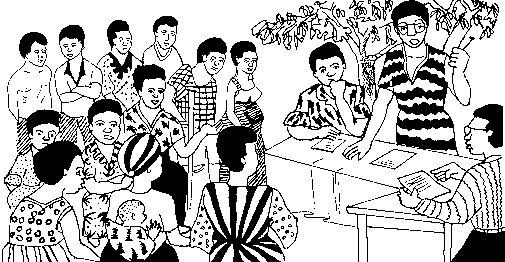Tweet
Translations:
'العربية / Al-ʿarabīyah
Català
English
Español
Filipino/Tagalog
Français
Ελληνικά / Elliniká
हिन्दी / Hindī
Italiano
Português
Română
Српски / Srpski
Türkçe
Other formats:
Other Pages:
Modules
Site Map
Key Words
Contact
Utility Documents
Useful Links
MEASURING EMPOWERMENT OR CAPACITY
Participants' Guidelines
by Phil Bartle, PhD
Workshop Handout
The facilitator will give you another handout to accompany this one. It will list sixteen variables or elements of community or organizational empowerment. Your job is to work with the other participants in this session to determine the changes in empowerment that have taken place over the last year and the last five years.
The sixteen elements appear to be mainly subjective in nature; there are no universally agreed upon units of measure or absolute scale against which you can make a measurement. This group measurement is designed with that in mind. What it seeks to do is to measure the increase (or decrease) in each of the elements.
Ideally, this session should be held every year, with the same participants and the same facilitator. Realistically that usually can not be done. Therefore it is very important for you to be consistent in making your personal measurement estimates.
The best way is to mentally make your own scale from 0 to 10. Accept that other participants may have different estimates than your own. Your "10" may be an imagined perfect community or organization. Your "0" may be impossible, like a frictionless physical state, but an absolutely powerless sociological state.
Put some number from 1 to 10 as your estimate of how it is today. Then put another number for how it was a year ago. If there has been no change, ensure that you put the same number both times. If there has been an increase, then last year's number will be smaller. If there has been a decline, then last year's number will be higher. Do the same for five years ago. Do this for every element; all sixteen.
The facilitator will call for participants to give their estimates, element by element, three numbers per element. Calmly report yours in turn. Other participants may give different numbers. That is OK, do not object or argue at this moment (there will be time to discuss this soon). The facilitator may put all the estimates up on the board. Think of this as like a brainstorm session; you contribute but do not contradict other participants.
The facilitator may simply calculate an average number for each of the three values for each of the sixteen elements. When this is on the board, there is now time to discuss the results. You may wish to remark that your estimate was above or below the group average. You may wish to discuss why a number changed form last year or five years ago (eg. a water supply became broken down; a new clinic was built; these would affect the estimates for communal facility).
The facilitator will ask people's opinions, especially from those who may not usually speak up in meetings. Consider those opinions and work with the whole group to come to a group consensus of what the measurements should be. Remember, it is OK to have different individual initial numbers, but you are working towards a group estimate.
The facilitator will then ask which of the elements have changed the most, and which the least, and why.
Every item is written on the board by the facilitator, and the recorder writes them down in a notebook, including any details that might be missed on the board.
The group estimates averages will be shifted on the board to indicate which elements changed the most and which the least.
A written record of the discussion will provide information to be interpreted as indicators of the amount of strengthening since the previous such discussion. If there have been more than one session in the past, the meeting might then go on to see if the rate of change was greater in the previous phase or the immediate past phase.
––»«––
A Workshop:
 |